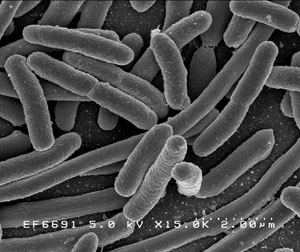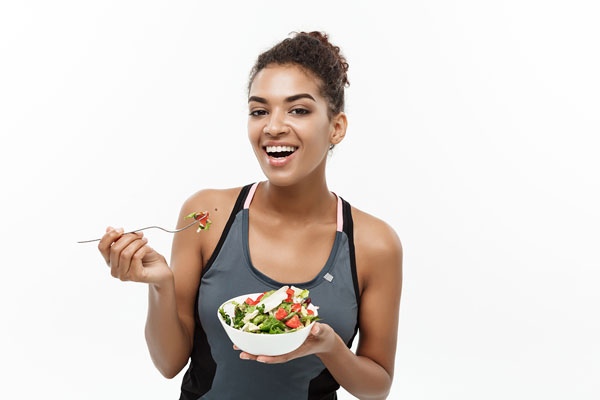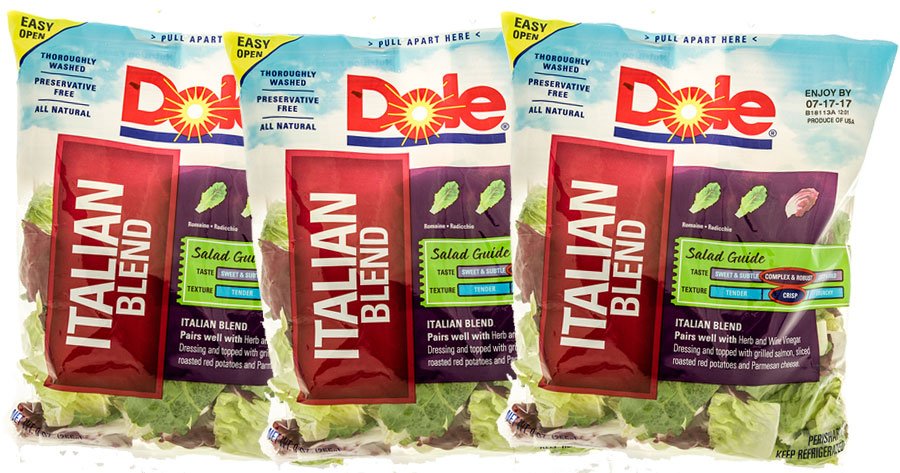This is not one of those “When I was growing up, we walked 20 miles barefoot through the snow to go to school” stories–although to Millennials it may seem like it. No, this is more along the lines of, “When I was growing up, we bought salad greens by the head from a bin in the supermarket.” And the truth is: that’s getting harder to do nowadays thanks to the advent of bagged salads.
So, what are bagged salads?
According to the Fresh Express website,1 http://www.freshexpress.com/about they invented the bagged salad in 1989. As they say, “We were the very first to successfully package and nationally distribute fresh-cut, ready-to-eat bagged salad. A few years later, we created our first delicious salad kits, filled with everything you need — even the dressing.” For what it’s worth, they also lay claim to the invention of iceberg lettuce. “The Fresh Express story started in the 1920s and 1930s when our founder and produce farmer, Bruce Church, grew and sold a plot of lettuce. He later formed an ice company to start shipping fresh heads of lettuce across the country in ice-packed rail cars. People started calling the produce aboard the ice trains “iceberg lettuce” and the name stuck.”
So, how big have bagged salads become?
Fresh Express alone produces nearly 40 million pounds of salad each month, with people consuming over 20 million servings a week. But that’s just the tip of the iceberg (all puns intended). Other companies such as Dole, Taylor Farms, and Earthbound Farms also sell massive amounts of bagged salads, as well as their close cousins, clamshell packed salads. In fact, per capita sales of fresh iceberg lettuce are down about 50% since Fresh Choice introduced bagged salads. Concomitantly, sales of bagged greens and salad kits have boomed, with sales increasing by about 6.5 percent a year. Sales now total about $7 billion a year and climbing.
Sales of bagged salads now total about $7 billion a year and climbing.
Yeah, But How Safe Are Bagged Salads?
“A [2010] Consumers Union test of 208 packages of salad greens, funded by the Pew Health Group, found no evidence of three pathogenic bacteria (E. coli O157:H7, Salmonella, and Listeria) that, when present in food, have made people sick and, in some cases, killed them.2 “Bacteria and Bagged Salads: Better Standards and Enforcement Needed” Consumers Union. February 2, 2010. (Accessed 23 March 2018.) http://consumersunion.org/pdf/BaggedSaladReport.pdf However, Consumers Union did find other bacteria, called “indicator organisms” (generic E. coli, Enterococcus, total and fecal coliforms), that are found in the digestive tract of humans, other animals, and the environment, and that public health officials say indicate inadequate sanitation, fecal contamination, and the potential for the presence of pathogenic bacteria.”
Although there are U.S. government standards for indicator organisms in milk, meat, drinking water, and even swimming water, there are no federal standards for these bacteria in salad greens. However, some 23 percent of the samples tested by Consumers Union exhibited levels of Enterococcus, and 39 percent showed levels of total coliforms, that several industry experts deem unacceptable in bagged salad.
Consumers Union found that bagged salads that were closer to their “use-by” date tended to have somewhat higher levels of these bacteria. Surprisingly (or perhaps not), the tests also found no significant differences between organic and non-organic greens.
So, are they safe or not?
Well, at first glance, you might think “not” with “incidents” in 2006, 2011, 2012, 2013, 2015, 2016, and 2017. But a closer examination makes the incidents much less ominous.
 2006, E. coli–1 dead, 100 sick
2006, E. coli–1 dead, 100 sick- 2011 Recalled for possible contamination
- 2012 Recalled for possible contamination
- 2013, cryptosporidium–372 cases of diarrhea
- 2015, Cyclospora–400 sick
- 2016, listeria–1 dead 12 sick
- 2017 Recalled for possible contamination
Well, three of the incidents weren’t technically incidents but, rather, precautionary recalls. As for the others, we’re talking about 2 people dead from food poisoning and fewer than a thousand people who got sick over a period of 11 years. To put that in perspective, the CDC estimates that EACH YEAR in the United States some 48 million people get sick, 128,000 are hospitalized, and 3,00 die from foodborne contamination.3 “Estimates of Foodborne Illness in the United States.” CDC. August 19, 2016. (Accessed 28 March 2018.) http://www.cdc.gov/foodborneburden/index.html In other words, sickness from bagged salads is but a tiny speck in the universe of foodborne illness. In summary, the risk from bagged salads is quite low, no higher than from the traditional wash-at-home lettuce heads I grew up with.
It also should be noted that since the 2006 E. coli outbreak linked to fresh bagged spinach as cited above,4 http://en.wikinews.org/wiki/E._coli_outbreak_kills_1%2C_sickens_nearly_100 the companies that process bagged salads have worked aggressively to reduce the risk of pathogens contaminating produce on their farms by testing irrigation water and trying to prevent birds and rodents from entering fields, as they can carry disease-causing pathogens. In addition, those same processors now tend to triple wash their greens before bagging them.
The bottom line is that detectable contamination in bagged salads is very low (typically less than 0.1%)–and most of those are for indicator organisms, not pathogenic organisms. And in those rare cases where pathogenic bacteria are discovered, the suspect salad bags are more often than not recalled before any adverse incidents can occur. In other words, safety concerns are not a reason to avoid bagged salads.
But Aren’t They Less Nutritious?
When it comes to bagged salads and nutrient loss, things may not be what they seem. Intuitively, you would think that there might be significant nutrient loss from washing in chlorinated water, chopping, bagging, and storing over time. But the reality is somewhat different–not totally different, but somewhat so. In other words, there appears to be some nutrient loss, but not much.
First off, minerals are stable. So, the mineral content remains mostly unchanged no matter what you do to the greens. Vitamins, on the other hand, are not so stable. Vitamins such as beta carotene tend to be sensitive to light, oxygen, and heat. To counter these threats, salad bags utilize a great deal of printing and graphics over much of their surface, which serves to protect the greens inside from excessive exposure to light. As for oxygen, the modified atmosphere in the bags replaces much of the oxygen content with carbon dioxide and/or nitrogen. Although used primarily to keep the greens “looking good,” the modified atmosphere also helps protect the contents from oxygen degradation. And finally, the bags are shipped in refrigerated trucks and kept on refrigerated shelves in stores, thus protecting the vitamins from heat damage. The bottom line is that studies have found that bagged, fresh-cut greens in modified-atmosphere packages (MAP) maintain most of their nutrients, including concentrations of vitamin C and flavonoids.5 Gil MI, Ferreres F, Tomás-Barberán FA. “Effect of postharvest storage and processing on the antioxidant constituents (flavonoids and vitamin C) of fresh-cut spinach.” J Agric Food Chem. 1999 Jun;47(6):2213-7. http://www.ncbi.nlm.nih.gov/pubmed/10794612 , 6 C.N. Kobori, L.S. Huber, C.I.G.L Sarantópoulos, D.B. Rodriguez-Amaya. “Behavior of Flavonols and Carotenoids of Minimally Processed Kale Leaves during Storage in Passive Modified Atmosphere Packaging.” Food Science. Volume76, Issue2, March 2011. Pages H31-H37. http://onlinelibrary.wiley.com/doi/full/10.1111/j.1750-3841.2010.01988.x To be sure, the first of those studies did note a loss of some antioxidant potential during storage. But other studies have found that the rate of loss for antioxidants in bagged salad is no different than the rate of loss found in un-bagged produce.7 Raffaella Preti, Giuliana Vinci. “Nutritional and sensory evaluation of ready-to-eat salads during shelf life.” Agro Food Industry Hi Tech 27(1):26-31 · January 2016. http://www.teknoscienze.com/getpdf.php?filename=Contents/Riviste/PDF/AF1_2016_LOW.pdf&beginpage=28&endpage=33&filetitle=Nutritional%20and%20sensory%20evaluationof%20ready-to-eat%20salads%20during%20shelf%20lif
But what about chopping? Doesn’t that affect nutrient value?
And yes, when it comes to chopping greens before bagging, you are damaging plant cells, and you are creating more surface area for oxidation to occur. But remember, the bags themselves provide a low-oxygen (MAP) environment which more than offsets the damage from chopping. Oxymoronically, there is also some evidence that “wounding” the flesh of vegetables (including lettuce) by chopping them stimulates the plant to produce more polyphenols as a defense mechanism.8 L.Fernando Reyes, J.Emilio Villarreal, LuisCisneros-Zevallos. “The increase in antioxidant capacity after wounding depends on the type of fruit or vegetable tissue.” Food Chemistry Volume 101, Issue 3, 2007, Pages 1254-1262. http://www.sciencedirect.com/science/article/pii/S0308814606002603 This is a good thing since polyphenols protect against, cancers, cardiovascular disease, diabetes, and neurodegenerative diseases. To put it another way, it seems the damage inflicted by chopping stimulates the release of polyphenols as a stress response by the plant–with that higher content of polyphenols now being available for your health.
There is evidence that “wounding” lettuce by chopping it, as in bagged salads, stimulates the lettuce to produce more polyphenols as a defense mechanism.
Also, it’s worth noting that fresh, un-bagged greens that are picked, harvested, and sold in supermarkets and places like Whole Foods do not have MAP packaging and, therefore, have been exposed to oxygen, light, and moisture–getting sprayed with water to stay cold and fresh multiple times every hour–so that there’s significant nutrient loss occurring day by day VS the bagged greens in their protective modified atmosphere packaging. In other words, the nutrient loss associated with bagged salads is not much different than you find with fresh greens sold in the markets.
And as for the fact that the vegetables and greens in bagged salads are washed in chlorinated water, at low concentrations of chlorine, as currently used, undesirable byproducts that might potentially be left on the produce such as chloroform and trihalomethanes are undetectable. And by controlling the wash water’s pH, chloramines are also avoided. In other words, washing with a chlorine solution may not sound great, but is essentially harmless and is more than offset by the killing of contaminating bacteria, which otherwise could continue to multiply to dangerous levels inside the bags.
How Long Do They Last?
 Okay, here’s one area in which bagged salads come up short–sort of.
Okay, here’s one area in which bagged salads come up short–sort of.
The large suppliers such as Fresh Express, Dole, Taylor Farms and Earthbound Farms are efficient when it comes to packaging and shipping. Bagged salads are usually harvested, packaged, and shipped to stores, all within 24 hours, give or take.
Also, as we’ve mentioned, bagged greens benefit from modified atmosphere packaging (MAP). MAP incorporates a blend of pure oxygen, carbon dioxide, and nitrogen, optimized specifically for the respiration needs of the salad greens contained within the sealed, permeable packaging that allows the package to “breathe” while still maintaining the optimized gas environment.9 “What is Modified Atmosphere Packaging (MAP)?” Mocon Dansenor. (Accessed 24 March 2018.) http://dansensor.com/solutions/modified-atmosphere-packaging-food-and-beverage-industry In this case, it means maintaining the atmosphere of less oxygen and more carbon dioxide and/or nitrogen optimized for the preservation of salad greens. The finely balanced MAP gas mix slows down the product aging process–i.e., reduced color loss, odor, and off-taste–resulting from product deterioration and spoilage caused by mold and other anaerobic organisms.
That said, once the salad bags are opened, the contents tend to go off far more quickly than normal heads of lettuce—often within a day or two. The bottom line is that bagged salads can last quite well before the bags are opened but don’t last long once the bags have been opened. In this regard, bagged salads come up short VS buying heads of lettuce.
So, What Am I Recommending?
All this information may cause to you to wonder: should you buy fresh heads of lettuce or bagged?
To be sure, there’s no question but that growing your own organic produce and eating it immediately after plucking from the garden is your best option. Buying from a local organic farm or farmer’s market may be a reasonable alternative. But unless you know and trust the farms doing the selling, can you be sure it’s truly organic–or even how fresh it is? Who’s to say that produce sitting in the farmer’s market hasn’t made the rounds of several other market venues before you finally got to see it. Regardless, as already mentioned, the nutrient loss associated with bagged salads is not much different than you find with fresh greens sold in the markets. Ultimately, the major negative associated with bagged salads is that they don’t last long once the bag is opened. But how much of an issue is that since you wouldn’t likely be opening the bag until you’re ready to use the salad?
In exchange, salad bags offer convenience and the option to experience a far greater variety of produce than you would ever have seen before their advent. Before bagged salads, your only real choices were iceberg and Romaine lettuce–and spinach. Now, thanks to bagging, you have access to kale, butter lettuce, red leaf, arugula, sweet lettuce, radicchio, and more–not to mention dozens of different salad kits.
Yes, all these plastic bags present a not-insignificant sustainability issue, but all this choice and convenience has led to increased consumption of salads. According to the U.S. Department of Agriculture, the availability/consumption of escarole, leaf, and Romaine lettuce has gone from a mere 0.5 pounds per person in 1979 to more than 11 pounds per in 2015. There are huge, huge health benefit hidden in that statistic. And as for the plastic bags, as consumers, we could demand that the salad packagers develop biodegradable packaging.
The bottom line is that for many people the convenience and variety offered by bagged salads completely overwhelms any potential freshness factor and has led to a massive increase in salad consumption. After closely examining the issue of bagged salads, the good outweighs the bad. Sustainability aside, I see no compelling reason to discourage their consumption for those who aren’t able to grow their own or buy from farms they know and trust.

References
| ↑1 | http://www.freshexpress.com/about |
|---|---|
| ↑2 | “Bacteria and Bagged Salads: Better Standards and Enforcement Needed” Consumers Union. February 2, 2010. (Accessed 23 March 2018.) http://consumersunion.org/pdf/BaggedSaladReport.pdf |
| ↑3 | “Estimates of Foodborne Illness in the United States.” CDC. August 19, 2016. (Accessed 28 March 2018.) http://www.cdc.gov/foodborneburden/index.html |
| ↑4 | http://en.wikinews.org/wiki/E._coli_outbreak_kills_1%2C_sickens_nearly_100 |
| ↑5 | Gil MI, Ferreres F, Tomás-Barberán FA. “Effect of postharvest storage and processing on the antioxidant constituents (flavonoids and vitamin C) of fresh-cut spinach.” J Agric Food Chem. 1999 Jun;47(6):2213-7. http://www.ncbi.nlm.nih.gov/pubmed/10794612 |
| ↑6 | C.N. Kobori, L.S. Huber, C.I.G.L Sarantópoulos, D.B. Rodriguez-Amaya. “Behavior of Flavonols and Carotenoids of Minimally Processed Kale Leaves during Storage in Passive Modified Atmosphere Packaging.” Food Science. Volume76, Issue2, March 2011. Pages H31-H37. http://onlinelibrary.wiley.com/doi/full/10.1111/j.1750-3841.2010.01988.x |
| ↑7 | Raffaella Preti, Giuliana Vinci. “Nutritional and sensory evaluation of ready-to-eat salads during shelf life.” Agro Food Industry Hi Tech 27(1):26-31 · January 2016. http://www.teknoscienze.com/getpdf.php?filename=Contents/Riviste/PDF/AF1_2016_LOW.pdf&beginpage=28&endpage=33&filetitle=Nutritional%20and%20sensory%20evaluationof%20ready-to-eat%20salads%20during%20shelf%20lif |
| ↑8 | L.Fernando Reyes, J.Emilio Villarreal, LuisCisneros-Zevallos. “The increase in antioxidant capacity after wounding depends on the type of fruit or vegetable tissue.” Food Chemistry Volume 101, Issue 3, 2007, Pages 1254-1262. http://www.sciencedirect.com/science/article/pii/S0308814606002603 |
| ↑9 | “What is Modified Atmosphere Packaging (MAP)?” Mocon Dansenor. (Accessed 24 March 2018.) http://dansensor.com/solutions/modified-atmosphere-packaging-food-and-beverage-industry |











